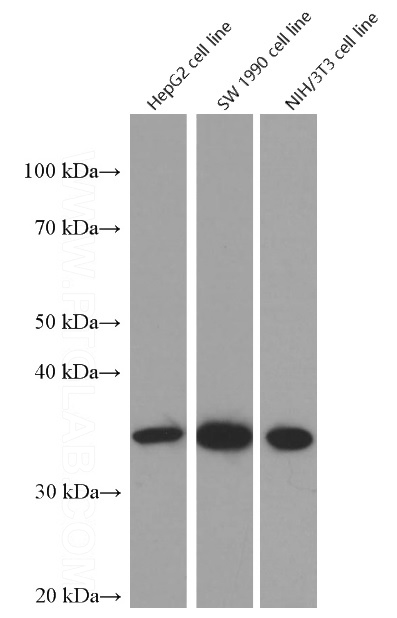-
Product Name
Cyclin D1 antibody
- Documents
-
Description
Cyclin D1 Mouse Monoclonal antibody. Positive WB detected in NIH/3T3 cells, A549 cells, HeLa cells, SH-SY5Y cells. Observed molecular weight by Western-blot: 36 kDa
-
Tested applications
ELISA, WB
-
Species reactivity
Human, Mouse; other species not tested.
-
Alternative names
B cell lymphoma 1 protein antibody; CCND1 antibody; cyclin D1 antibody; D11S287E antibody; G1/S specific cyclin D1 antibody; PRAD1 antibody; PRAD1 oncogene antibody; U21B31 antibody
-
Isotype
Mouse IgG2b
-
Preparation
This antibody was obtained by immunization of Cyclin D1 recombinant protein (Accession Number: NM_053056). Purification method: Protein A purified.
-
Clonality
Monoclonal
-
Formulation
PBS with 0.02% sodium azide and 50% glycerol pH 7.3.
-
Storage instructions
Store at -20℃. DO NOT ALIQUOT
-
Applications
Recommended Dilution:
WB: 1000-10000
-
Validations

Western blot of Cyclin D1 in HepG2,SW 1990 and NIH/3T3 cell lines with Catalog No:107190 at dilution of 1:10000
-
Background
CCND1 (cyclin D1), also known as PRAD1 or BCL1, belongs to the highly conserved cyclin family, whose members are characterized by a dramatic periodicity in protein abundance throughout the cell cycle. CCND1 forms a complex with and functions as a regulatory subunit of CDK4 or CDK6, whose activity is required for cell cycle G1/S transition. The CCND1 gene, located on 11q13 has been reported to be overexpressed in mantle cell lymphoma (MCL) due to the chromosomal translocation. CCND1 has been shown to interact with tumor suppressor protein Rb and the expression of this gene is regulated positively by Rb. Over-expression of CCND1 is known to correlate with the early onset of cancer and risk of tumor progression and metastasis.
-
References
- Song Y, Xue L, Du S. Caveolin-1 knockdown is associated with the metastasis and proliferation of human lung cancer cell line NCI-H460. Biomedicine & pharmacotherapy = Biomédecine & pharmacothérapie. 66(6):439-47. 2012.
- Hu HM, Chen Y, Liu L. C1orf61 acts as a tumor activator in human hepatocellular carcinoma and is associated with tumorigenesis and metastasis. FASEB journal : official publication of the Federation of American Societies for Experimental Biology. 27(1):163-73. 2013.
- Wang Y, Jiang L, Ji X, Yang B, Zhang Y, Fu XD. Hepatitis B viral RNA directly mediates down-regulation of the tumor suppressor microRNA miR-15a/miR-16-1 in hepatocytes. The Journal of biological chemistry. 288(25):18484-93. 2013.
- Zheng L, Wang X, Luo W, Zhan Y, Zhang Y. Brucine, an effective natural compound derived from nux-vomica, induces G1 phase arrest and apoptosis in LoVo cells. Food and chemical toxicology : an international journal published for the British Industrial Biological Research Association. 58:332-9. 2013.
- Chen S, Li X, Lu D. SOX2 regulates apoptosis through MAP4K4-survivin signaling pathway in human lung cancer cells. Carcinogenesis. 35(3):613-23. 2014.
- Sun Q, Wang R, Wang Y, Luo J, Wang P, Cheng B. Notch1 is a potential therapeutic target for the treatment of human hepatitis B virus X protein-associated hepatocellular carcinoma. Oncology reports. 31(2):933-9. 2014.
- Tang J, Tao ZH, Wen D. MiR-612 suppresses the stemness of liver cancer via Wnt/β-catenin signaling. Biochemical and biophysical research communications. 447(1):210-5. 2014.
- Song Y, Gong K, Yan H. Sj7170, a unique dual-function peptide with a specific α-chymotrypsin inhibitory activity and a potent tumor-activating effect from scorpion venom. The Journal of biological chemistry. 289(17):11667-80. 2014.
Related Products / Services
Please note: All products are "FOR RESEARCH USE ONLY AND ARE NOT INTENDED FOR DIAGNOSTIC OR THERAPEUTIC USE"
